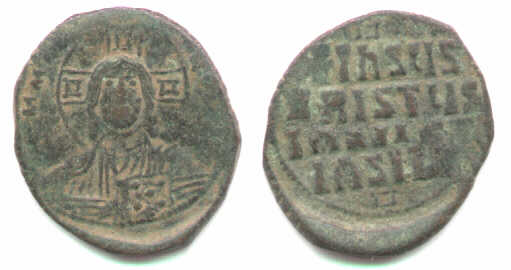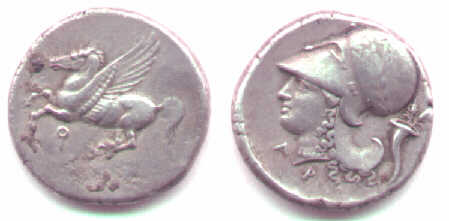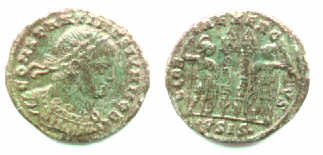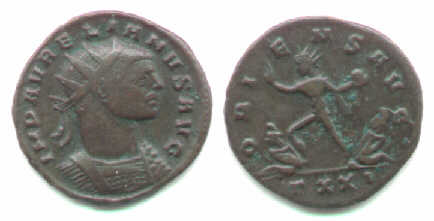Ancient Roman and Greek Coins, Common Types

An example, in very high grade, of the type from 330-337 AD of CONSTANTINOPOLIS, "Constantine's city." Even in this high grade it is avaiable in the $40 range. The reverse shows Victory with her foot on a tiny ship's prow. It commemorates a naval battle which secured the site of the city for Constantine.

Copper. 30 mm diameter. A very common large Byzantine coin of Basil II and Constantine VIII, AD 976-1028. It costs about $20 - $40 in this condition (which is well above average). The obverse shows a facing bust of Christ (with a halo) and the reverse says "Jesus Christ, ruler of kings" in Greek. Nowhere is John mentioned, which is why this type of coin is called an "anonymous" bronze.

Silver. 26 mm diameter. A large and thick silver coin of Alexander the Great. The obverse is a bust of Hercules in a lion-skin headdress. The reverse shows Zeus (Jupiter) seated, holding an eagle. The legend "King Alexander" in Greek begins at 8:00. This example is more worn than most -- it should cost about $175.

Silver. 21 mm. A common (but not cheap) coin of of the Greek city Corinth, minted 350 - 300 BC. Pegasus (the winged horse) / head of the goddess Athena in a Corinthian helmet (tipped back to expose the face). A cornucopia is behind. It is the size of a nickle, but thicker. Cost, about $350.

A Greek copper coin of the city Pantikapion (at the north end of the Black Sea), from the 4th century BC. Pan (notice the pun on the name of the city) / bull's head. This is good artwork for a small coin of only 16mm diameter. It costs about $50 - $100 in this high grade.

The reverse of two soldiers and two military standards is very common. Struck 330 - 335 (and a one-standard version was stuck 335-340) by Constantine and his sons 330-335 AD (this one is by Constantine II), it is very common in sizes 18-15mm. It can be bought for $5-$15.

The radiate crown on this coin of Gordian III, Roman emperor AD 238-244, indicates that this silver coin is an "antoninianus," (fondly called an "ant" or "radiate"), an extremely common denomination struck by numerous emperors from 215 to 294. The amount of silver steadily decreases, so radiates from later in the century may appear to be copper almost without silver. This example is 22x20 mm, but some are a bit smaller. Some reverse types are of special interest, but most radiates are very common. Coins of Gordian III are very commonly found in high grade so in this condition is worth only $20-$35.

Another radiate, this one almost without silver, of Aurelian, Roman emperor AD 270-275. The reverse shows the sun god, Sol, with two captives, and the legend ORIENS AVG, which refers to the east (as in "orient") and the rising sun and Aurelian's victories in the east. Coins of Aurelian (a very interesting emperor) are very commonly found in high grade so one like this is worth only $20-$40.
Return to the link about "common" ancient coin types.
or
Return to the beginning of page 3 of Ancient Roman and Greek Coins.
Return to the beginning of page 1 of Ancient Roman and Greek Coins.
Return to the beginning of page 2 of Ancient Roman and Greek Coins.







